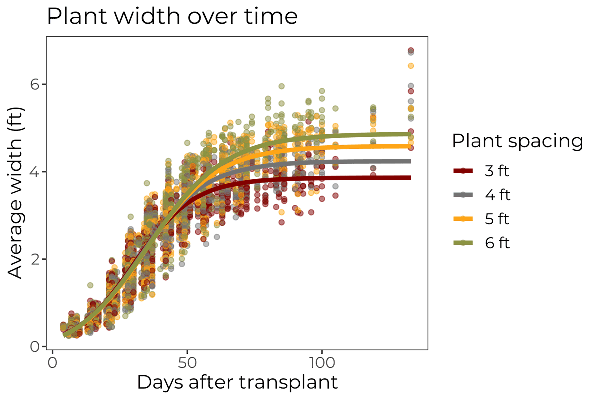The payment structures for floral hemp (Cannabis sativa L. < 0.3% total THC) are commonly based on the percentage of cannabidiol (CBD) per pound of biomass. To maximize profit, farmers try to produce high CBD content material or biomass. In Understanding the Relationship between THC and CBD in Hemp, we demonstrated that maximizing the CBD content will always result in a non-compliant amount of THC (>0.3%). Furthermore, we found that hemp must be harvested prematurely (prior to maximal CBD content and biomass production) in order to stay below the THC compliance threshold. Since we are limited to 6% to 8% CBD, the focus should be on increasing biomass production per acre to generate maximum profits.
Hemp is a day length-sensitive, short day plant. This means that the plant will grow vegetatively as long as the day length exceeds a specific threshold, which is known as the critical photoperiod. When the days shorten below this critical photoperiod, the plant will stop growing vegetatively and will shift into the reproductive phase. The critical photoperiod for hemp ranges from 13 to 14 hours of light and depends somewhat on the variety (Stack et al. 2020). Hypothetically, the longer a hemp plant grows vegetatively, the more biomass it will produce by the end of the season. To better understand this, we conducted field trials in 2020 and 2021. We investigated transplant timing and spacing in order to develop production recommendations that generate the highest per-acre biomass.
We conducted field trials in Salisbury at Piedmont Research Station (Figure 1), Kinston at Cunningham Research Station, and Jackson Springs at the Sandhills Research Station. We used clones of ‘BaOx’ floral hemp in all locations and both years. Transplanting occurred May 11 and continued every two weeks until July 6 (5 transplant times). See Table 1. At each transplant date, we had four within-row plant spacing treatments at 3, 4, 5, and 6 ft. Between-row spacing was 5 ft at all locations, which resulted in plant populations that ranged from 2,904 to 1,452 plants per acre.
| Transplant Date | Plant Spacing (ft) | Plant Density (plants/acre) |
|---|---|---|
| May 11 | 3 | 2,904 |
| May 25 | 4 | 2,178 |
| June 8 | 5 | 1,742 |
| June 22 | 6 | 1,452 |
| July 6 |
We measured plant height and width every week after transplant until two weeks after flowering, which occurred during the third week of August (approximately 13.5 hours of day length). We harvested plants six weeks after floral initiation, dried them in tobacco barns, threshed the floral and leaf material, and weighed the resultant biomass.
Plant height (Figure 2) and width (Figure 3) showed similar trends: earlier transplant dates resulted in taller and wider plants.
We did not see any effect of plant spacing on plant height. However, plant width was affected by plant spacing; wider between-plant spacing resulted in wider plants (Figure 4). Larger plants, in terms of height and width, were achieved through the earliest and widest transplanting treatments.
Biomass yields per plant were affected by both plant spacing and transplant date (Figure 5). Yields were highest with the 6 ft spacing, regardless of transplant date, and lowest from 3 ft spacing. Regardless of the spacing treatment, we found a significant linear decrease in per-plant biomass. For every day we waited after the initial May 11 transplant date, we lost 6.8 grams of potential biomass.
When we converted yields to a per-acre basis, we found the reverse in the effect of plant spacing. The yields were highest from the 3 ft spacing and decreased with wider plant spacing (Figure 6). This indicated that higher plant populations are more important in terms of yield per acre than the gains obtained on a per-plant basis by wider spacing. Similar to the per-plant results, we found a significant linear decrease in yield over time. For every day we waited after the May 11 transplant date, we lost 28.5 lb per acre of potential biomass. This means that waiting 10 days after May 11 to transplant would result in a loss of 285 lb per acre of biomass (10 days × -28.5 lb per acre per day).
Key Takeaways
- To maximize yield on a per acre basis, farmers should transplant early and at a narrow between-plant spacing.
- Increased plant populations can reduce airflow within and between plants and may lead to increased disease pressure. In warm, wet climates, leaving room between plants can help to reduce the incidence of disease.
- More plants per acre means increased cost of production. Farmers should use hypothetical budgets to determine if the added cost is worth the investment. See enterprise budgets from the University of Kentucky for an excellent tool for developing production budgets.
Literature Cited
Stack, George M., Jacob A. Toth, Craig H. Carlson, Ali R. Cala, Mariana I. Marrero-González, Rebecca L. Wilk, Deanna R. Gentner, et al. 2021. “Season-long Characterization of High-Cannabinoid Hemp (Cannabis sativa L.) Reveals Variation in Cannabinoid Accumulation, Flowering Time, and Disease Resistance.” GCB Bioenergy 13, no. 4: 546-561.
Publication date: Sept. 8, 2022
AG-938
N.C. Cooperative Extension prohibits discrimination and harassment regardless of age, color, disability, family and marital status, gender identity, national origin, political beliefs, race, religion, sex (including pregnancy), sexual orientation and veteran status.






